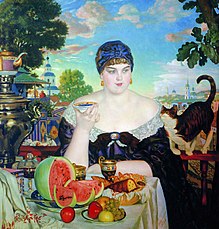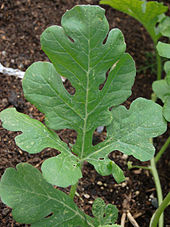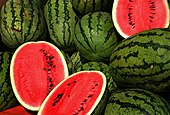| Watermelon | |
|---|---|
 | |
| Scientific classification | |
| Kingdom: | Plantae |
| (unranked): | Angiosperms |
| (unranked): | Eudicots |
| (unranked): | Rosids |
| Order: | Cucurbitales |
| Family: | Cucurbitaceae |
| Genus: | Citrullus |
| Species: | C. lanatus |
| Binomial name | |
| Citrullus lanatus (Thunb.) Matsum. & Nakai | |
 | |
| Watermelon output in 2005 | |
Contents
|
History
Watermelon is thought to have originated in southern Africa, where it is found growing wild, because it reaches maximum genetic diversity there, resulting in sweet, bland and bitter forms. Alphonse de Candolle, in 1882,[2] already considered the evidence sufficient to prove that watermelon was indigenous to tropical Africa.[3] Though Citrullus colocynthis is often considered to be a wild ancestor of watermelon and is now found native in north and west Africa, Fenny Dane and Jiarong Liu[4] suggest on the basis of chloroplast DNA investigations that the cultivated and wild watermelon appear to have diverged independently from a common ancestor, possibly C. ecirrhosus from Namibia.It is not known when the plant was first cultivated, but Zohary and Hopf note evidence of its cultivation in the Nile Valley from at least as early as the second millennium BC. Although watermelon is not depicted in any Egyptian hieroglyphic text nor does any ancient writer mention it, finds of the characteristically large seed are reported in Twelfth dynasty sites; numerous watermelon seeds were recovered from the tomb of Pharaoh Tutankhamun.[5]
By the 10th century AD, watermelons were being cultivated in China, which is today the world's single largest watermelon producer. By the 13th century, Moorish invaders had introduced the fruit to Europe; according to John Mariani's The Dictionary of American Food and Drink, "watermelon" made its first appearance in an English dictionary in 1615.
Museums Online South Africa list watermelons as having been introduced to Native Americans in the 16th century. Early French explorers found Native Americans cultivating the fruit in the Mississippi Valley. Many sources list the watermelon as being introduced in Massachusetts as early as 1629. Southern food historian John Egerton has said he believes African slaves helped introduce the watermelon to the United States. Texas Agricultural Extension horticulturalist Jerry Parsons lists African slaves and European colonists as having distributed watermelons to many areas of the world. Parsons also mentions the crop being farmed by Native Americans in Florida (by 1664) and the Colorado River area (by 1799). Other early watermelon sightings include the Midwestern states (1673), Connecticut (1747) and the Illiana region (1822).
Charles Fredric Andrus, a horticulturist at the USDA Vegetable Breeding Laboratory in Charleston, South Carolina, set out to produce a disease-resistant and wilt-resistant watermelon. The result was "that gray melon from Charleston." Its oblong shape and hard rind made it easy to stack and ship. Its adaptability meant it could be grown over a wide geographical area. It produced high yields and was resistant to the most serious watermelon diseases: anthracnose and fusarium wilt.
Today, farmers in approximately 44 states in the U.S. grow watermelon commercially, and almost all these varieties have some Charleston Gray in their lineage. Georgia, Florida, Texas, California and Arizona are the USA's largest watermelon producers.
This now-common watermelon is often large enough that groceries often sell half or quarter melons. There are also some smaller, spherical varieties of watermelon, both red- and yellow-fleshed, sometimes called "icebox melons."
In Japan, farmers of the Zentsuji region found a way to grow cubic watermelons, by growing the fruits in glass boxes and letting them naturally assume the shape of the receptacle.[6] The square shape is designed to make the melons easier to stack and store, but the square watermelons are often more than double the price of normal ones. Pyramid shaped watermelons have also been developed and any polyhedral shape may potentially also be used.
Culture
For commercial plantings, one beehive per acre (4,000 m² per hive) is the minimum recommendation by the US Department of Agriculture for pollination of conventional, seeded varieties. Because seedless hybrids have sterile pollen, pollinizer rows of varieties with viable pollen must also be planted. Since the supply of viable pollen is reduced and pollination is much more critical in producing the seedless variety, the recommended number of hives per acre, or pollinator density, increases to three hives per acre (1,300 m² per hive).Nutrition
| Nutritional value per 100 g (3.5 oz) | |
|---|---|
| Energy | 127 kJ (30 kcal) |
| Carbohydrates | 7.55 g |
| Sugars | 6.2 g |
| Dietary fiber | 0.4 g |
| Fat | 0.15 g |
| Protein | 0.61 g |
| Water | 91.45 g |
| Vitamin A equiv. | 28 μg (3%) |
| Thiamine (Vit. B1) | 0.033 mg (3%) |
| Riboflavin (Vit. B2) | 0.021 mg (1%) |
| Niacin (Vit. B3) | 0.178 mg (1%) |
| Pantothenic acid (B5) | 0.221 mg (4%) |
| Vitamin B6 | 0.045 mg (3%) |
| Folate (Vit. B9) | 3 μg (1%) |
| Vitamin C | 8.1 mg (14%) |
| Calcium | 7 mg (1%) |
| Iron | 0.24 mg (2%) |
| Magnesium | 10 mg (3%) |
| Phosphorus | 11 mg (2%) |
| Potassium | 112 mg (2%) |
| Zinc | 0.10 mg (1%) |
| Percentages are relative to US recommendations for adults. Source: USDA Nutrient database | |
Notable is the inner rind of the watermelon, which is usually a light green or white color. This area is edible and contains many hidden nutrients that most people avoid eating due to its unappealing flavor.
The amino acid citrulline was first extracted from watermelon and analysed.[8] Watermelons contain a significant amount of citrulline and after consumption of several kg, an elevated concentration is measured in the blood plasma; this could be mistaken for citrullinaemia or other urea cycle disorders.[9]
Watermelon rinds are also edible, and sometimes used as a vegetable.[10] In China, they are stir-fried, stewed or more often pickled. When stir-fried, the de-skinned and de-fruited rind is cooked with olive oil, garlic, chili peppers, scallions, sugar and rum. Pickled watermelon rind is also commonly consumed in the Southern US.[11] Watermelon juice can also be made into wine.[12]
Watermelon is also mildly diuretic.[13]
Watermelons contain large amounts of beta carotene.[14]
Watermelon with red flesh is a significant source of lycopene.
Varieties
There are more than 1200[15] varieties of watermelon ranging in size from less than a pound, to more than two hundred pounds, with flesh that is red, orange, yellow or white.[16] Several notable varieties are included here.- Carolina Cross: This variety of watermelon produced the current world record watermelon weighing 262 pounds (119 kg). It has green skin, red flesh and commonly produces fruit between 65 and 150 pounds (29 and 68 kg). It takes about 90 days from planting to harvest.[17]
- Yellow Crimson Watermelon: variety of watermelon that has a yellow colored flesh. This particular type of watermelon has been described as "sweeter" and more "honey" flavored than the more popular red flesh watermelon.[18]
- Orangeglo: This variety has a very sweet orange pulp, and is a large oblong fruit weighing 9–14 kg (20–30 pounds). It has a light green rind with jagged dark green stripes. It takes about 90–100 days from planting to harvest.[19]
- The Moon and Stars variety of watermelon has been around since 1926.[20] The rind is purple/black and has many small yellow circles (stars) and one or two large yellow circles (moon). The melon weighs 9–23 kg (20–50 pounds).[21] The flesh is pink or red and has brown seeds. The foliage is also spotted. The time from planting to harvest is about 90 days.[22]
- Cream of Saskatchewan: This variety consists of small round fruits, around 25 cm (10 inches) in diameter. It has a quite thin, light green with dark green striped rind, with sweet white flesh and black seeds. It can grow well in cool climates. It was originally brought to Saskatchewan, Canada by Russian immigrants. These melons take 80–85 days from planting to harvest.[23]
- Melitopolski: This variety has small round fruits roughly 28–30 cm (11–12 inches) in diameter. It is an early ripening variety that originated from the Volga River region of Russia, an area known for cultivation of watermelons. The Melitopolski watermelons are seen piled high by vendors in Moscow in summer. This variety takes around 95 days from planting to harvest.[24]
- Densuke Watermelon: This variety has round fruit up to 25 lb (11 kg). The rind is black with no stripes or spots. It is only grown on the island of Hokkaido, Japan, where up to 10 000 watermelons are produced every year. In June 2008, one of the first harvested watermelons was sold at an auction for 650 000 yen (6300 USD), making the most expensive watermelon ever sold. The average selling price is generally around 25 000 yen (250 USD).[25]
Cultural uses and references

Watermelon and other fruit in Boris Kustodiev's Merchant's Wife.
- In Vietnamese culture, watermelon seeds are consumed during the Vietnamese New Year's holiday, Tết, as a snack.[26]
- Stereotypical caricatures may depict African Americans as being inordinately fond of watermelon.[27]
- The Oklahoma State Senate passed a bill on 17 April 2007 declaring watermelon as the official state vegetable, with some controversy surrounding whether a watermelon is a fruit.[28]
- The citrulline which exists in watermelon (especially in the rind) is a known stimulator of nitric oxide. Nitric oxide is thought to relax and expand blood vessels, much like the erectile dysfunction drug Viagra, and may even increase libido.[29]
- Fans of the Saskatchewan Roughriders of the CFL started a tradition of hollowing out a watermelon and wearing it as a makeshift football helmet (the color of the Roughriders is green). During the 2009 Grey Cup in Calgary (between the Montreal Alouettes and the Roughriders), thousands of watermelons had to be imported to Calgary supermarkets to prevent a shortage being caused by Rider fans.[30]
- The town of Chinchilla in Queensland, Australia holds a biannual festival celebrating all things melon.
- The Ten-lined June beetle is often affectionately referred to as a Watermelon Beetle, due to the green, striped pattern on its back.
Gallery
- Flower stems of male and female watermelon blossoms, showing ovary on the female











No comments:
Post a Comment